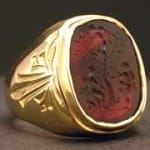Classical Revival Carnelian Intaglio Three Putti, 18th Century CE
Carnelian-Gold
FJ.6778
This Gorgeous Seal Has Been Mounted in a Modern 18 Karat Gold Rin The art of glyptics, or carving on colored precious stones, is probably one of the oldest known...
This Gorgeous Seal Has Been Mounted in a Modern 18 Karat Gold Rin
The art of glyptics, or carving on colored precious stones, is probably one of the oldest known to humanity. Intaglios, gems with an incised design, were made as early as the fourth and third millennia B.C. in Mesopotamia and the Aegean Islands. The exhibit a virtuosity of execution that suggests an old and stable tradition rooted in the earliest centuries. The tools required for carving gems were simple: a wheel with a belt-drive and a set of drills. Abrasives were necessary since the minerals used were too hard for a metal edge. A special difficulty of engraving intaglios, aside from their miniature size, was that the master had to work with a mirror-image in mind.
The Classical Revival was a phenomenon that swept through Europe in the 18th and 19th Centuries. A new appreciation for antiquity and ancient art forms was fostered by discoveries in the nascent scientific field of archaeology. Perhaps the Classical Revival also reveals a latent longing towards the Arcadian lifestyles of yesterday abandoned as Europe became rapidly industrialized and increasingly urbanized. On this stunning intaglio, three putti (Italian for “little boys”) play in a tree. Although this seal imitates an ancient art form, putti did not become popularized until the renaissance. One might suspect this to be the god Cupid, due to their almost indistinguishable physiques; however, the presence of multiple figures lends itself to the cherub attribution. Even so, the symbolism of this scene remains an intriguing mystery. Although the meaning of this intaglio is shrouded, we can surely enjoy the remarkable beauty of the gemstone itself and the technical expertise of the artistry. Such a lovely ring is worthy of being considered along with the classics it emulates.
The art of glyptics, or carving on colored precious stones, is probably one of the oldest known to humanity. Intaglios, gems with an incised design, were made as early as the fourth and third millennia B.C. in Mesopotamia and the Aegean Islands. The exhibit a virtuosity of execution that suggests an old and stable tradition rooted in the earliest centuries. The tools required for carving gems were simple: a wheel with a belt-drive and a set of drills. Abrasives were necessary since the minerals used were too hard for a metal edge. A special difficulty of engraving intaglios, aside from their miniature size, was that the master had to work with a mirror-image in mind.
The Classical Revival was a phenomenon that swept through Europe in the 18th and 19th Centuries. A new appreciation for antiquity and ancient art forms was fostered by discoveries in the nascent scientific field of archaeology. Perhaps the Classical Revival also reveals a latent longing towards the Arcadian lifestyles of yesterday abandoned as Europe became rapidly industrialized and increasingly urbanized. On this stunning intaglio, three putti (Italian for “little boys”) play in a tree. Although this seal imitates an ancient art form, putti did not become popularized until the renaissance. One might suspect this to be the god Cupid, due to their almost indistinguishable physiques; however, the presence of multiple figures lends itself to the cherub attribution. Even so, the symbolism of this scene remains an intriguing mystery. Although the meaning of this intaglio is shrouded, we can surely enjoy the remarkable beauty of the gemstone itself and the technical expertise of the artistry. Such a lovely ring is worthy of being considered along with the classics it emulates.



